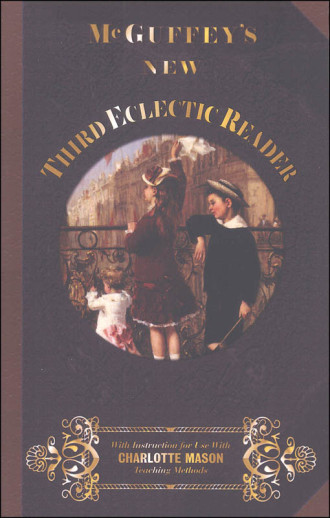We use cookies to make your experience better. To comply with the new e-Privacy directive, we need to ask for your consent to set the cookies. Learn more.
McGuffey's New Third Eclectic Reader (with instructions for use with Charlotte Mason teaching methods)
Emphasis on articulation and punctuation, with language arts lessons based upon character building stories, essays and poetry. Focus: reading and spelling (86 lessons).
The third reader begins with lessons on articulation and marks and pauses (punctuation). The articulation lesson reviews some of the words from the last half of the second reader, while the punctuation instruction provides a brief overview of the basic punctuation marks and their uses. Each of these lessons includes a note to the teacher and the articulation lesson includes a model for class drill.
These introductory lessons are followed by 86 language arts lessons, each based upon character-building stories, essays, and poetry. Each paragraph or stanza is numbered, which makes it very easy to assign portions of a passage or poem as copywork, recitation, or narration. Additional short lessons and teacher notes are found throughout the text.
In this reader, students will find spelling words listed at the beginning of each lesson. The first spelling and vocabulary lesson in the third reader contains words from the story that follows, including learn, richly, culling, harvest, cause, wintry, engage, livelong, youth, summer, leaving, and brightest. Practice Spelling with McGuffey Readers provides an overview of how to use these spelling words.
Most stories and nonfiction pieces are followed by a few questions about the text. In her review of the 1857 Readers, Cathy Duffy writes about a question in the third reader, "The first instruction to relate the story is essentially asking the child for an oral narration. The following two questions require students to think beyond the content of the story for their answers. This guided discussion stretches beyond narration but still fits the spirit of Charlotte Mason's ideas.
You may choose whether or not to use the provided questions. I strongly dislike comprehension questions, so would not use any that were simply questions of fact, but would instead substitute narration or a simple conversation about the story or poem. The nice thing about the third reader, as with the rest of the series, is that you may adapt it to suit your needs.
New introduction with instructions for use with Charlotte Mason methods
You may also choose to use Charlotte Mason's language arts methods of copywork, recitation, and narration for these lessons. Instructions for each of these methods is found in the new 18-page introduction that has been added to this edition. Like Miss Mason, Mr. McGuffey believed in short lessons, learned well, so the readers provide a convenient source for material to use with Miss Mason's methods.
By the end of the third reader, your student will be working with words such as island, bilberry, brooding, fledged, captivity, busy, hobble, warbled, and grateful.
Literacy, virtue, and values
Like the other readers in the series, McGuffey's third reader helps you teach language arts using stories, poems, essays, and speeches that reinforce virtues such as courage, honor, diligence, stewardship, independence, frugality, perseverance, and kindness. Whether you use them as a primary instructional tool or simply as a supplement to your curriculum, I think you'll find the 1857 McGuffey Readers a valuable addition to your home library and classroom.
Homeschool families have cherished the McGuffey Readers for years. Whether the classic tales and academically rigorous content or the nostalgic sentiment that overcomes us as we behold these charming readers, we simply can't get enough. Yet, if you are like me, the struggle to effectively use these classics in your children's education is tangible. Thankfully, Janice Campbell has provided us with Readers with detailed instruction for integrating them into a Charlotte Mason methodology. Focusing on Miss Mason's guiding principles of copywork, narration, recitation and dictation, Mrs. Campbell provides nearly 20 pages of elaboration/teaching on the CM approach on the McGuffey Readers as a core language arts curriculum for today's students (she also notes that families are welcome to simply enjoy the beauty of the McGuffey Readers for reading practice, without embracing Miss Mason's language arts ways).
Each volume contains the original text, graphics, and diacritical markings from McGuffey's 1857 edition, which was carefully selected for numerous reasons. The 1857 editions were the first editions with 6 readers (with readers 5 and 6 added to provide high school literature, reading and elocution practice), and they were the last edition with which Mr. McGuffey was personally involved in reviewing. These readers reflect the values and ideas of the 19th century, which are clearly taught from a Christian perspective. One belief that is occasionally present is the idea that being good or kind is a prerequisite for being loved, and in these rare occasions, Mrs. Campbell counsels parents to stress that negative behavior does have consequences, yet children are always loved. This edition also contains additional teaching notes with a greater focus on articulation and elocution for all ages, something that is sadly missing from today's language arts curricula. Interestingly, Mrs. Campbell shares her long-held personal belief that many spelling and reading difficulties can be attributed to incorrect or unclear pronunciation; and while not guaranteed, her premise of focusing on clear pronunciation and proper expression may provide an advantage to struggling students. See below for content details. The softcover books measure 5" x 7.5", contain 102-448 pgs, and are available individually or in sets. ~Deanne
| Product Format: | Paperback |
|---|---|
| Brand: | Everyday Education |
| Grades: | 3-5 |
| ISBN: | 9781613220177 |
| Length in Inches: | 7.75 |
| Width in Inches: | 5.0625 |
| Height in Inches: | 0.625 |
| Weight in Pounds: | 0.625 |

